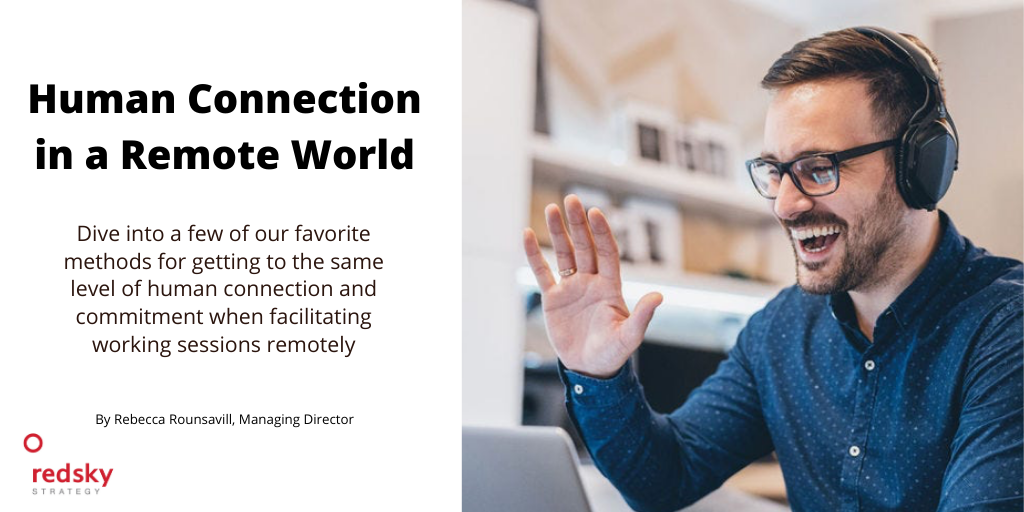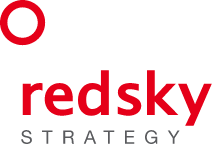News
Human Connection in a Remote World

By Rebecca Rounsavill, Managing Director
A few weeks into quarantine, we got that harsh, proverbial slap on the face realization that it wasn’t going to be “over” any time soon. Those workshops that we had delayed “until quarantine ends” weren’t going to happen. We needed to adapt quickly or let competitors pass us by. And thus, began our migration to our new reliance on online toolset like Zoom, Microsoft Teams, Google Docs, Mural, Trello, Slack and a host of other programs. This toolset enabled us to communicate and get through our agendas effectively, but somehow, it still didn’t feel like we were operating at 100%.
We were missing the magic that happens with face-to-face collaboration, where people feel a sense of community with the team, where they compromise if necessary, for the greater good, put forth their greatest effort, and best of all, build on each other’s thinking to create big ideas and more impactful solutions. We had the mechanics right, but we were missing the human element. How do you get to the same level of human connection and commitment when facilitating working sessions remotely?
Below are a few of our favorite methods. For the Ice Breakers and Energizers, make sure you use a timer or they can drag on way too long, enjoying the camaraderie and laughter.
1. Methods to ensure 100% Focus and Engagement.
Demand that every team member is FULLY present during meetings. What does this mean?
- Require videos. No turning off the camera to fold your laundry. Videos are on so that we can see you and read your reactions.
- Ensure competency on new toolsets. Take the time pre-meeting to train those less skilled, ensuring that everyone can fully engage in the discussion, and not fade into the background. Use home-works to spot laggards.
- Active agendas. Build in times to check-in, moments for individual contributions, and areas of 1on1 or small sub-team activities to ensure everyone is participating equally.
2. Ice Breakers.
Before online workshops start, take the time for teams to bond. Some fun ideas….
- Scrap Booking: Before the meeting, ask everyone on the team to send you pictures of five items along with a picture of yourself (e.g., your home workspace (with any identifying items removed), your smart phone cover, your favorite coffee mug, your favorite snack, your favorite COVID meme, etc.) Before the meeting, upload all pictures onto your whiteboard program (or PowerPoint if you don’t use one). Start a scrapbook page for each person on the team. At the start of the meeting, ask everyone to sort the items onto the scrapbook page of the person to whom you think the items belong. Bragging rights goes to the person who gets the most items correct.
- Scavenger Hunt: Break your team up into two to three person sub-teams (Zoom meeting rooms are great for this.) Ask them to find items from around their house for the hunt. This will force people to work together, see into each other’s homes and take screenshots of each other for the competition. Choosing fun items will stimulate great conversations (craziest socks, favorite book, kids doing funny things, zoom shirt collection, etc.). Visit Goosechase.com for more elaborate ideas.
3. Energizers
- Blind Truth Drawing Contest: This will put the team into a creative mindset. Have each person find a piece of paper and a pencil. Choose a picture to show the team – one with multiple elements. Then, ask them to close their eyes and recreate it! Looking at the drawings is always hilarious. Count the elements and give a prize to whoever remembered the most from the picture or for the best drawing. Make sure you can see everyone’s eyes so that there’s no cheating!

- Low Hanging Fruit: This is a quick and easy game that will get your team moving and helps create energy when losing momentum during brainstorming. You can call out a category like, “yellow” or “coffee mugs” and give teams 1-2 minutes to run around their house and grab every item they see that falls into the category. Anyone back late is automatically disqualified. The person with the most items wins. It is also a great reminder during innovation training for example, that the “low hanging fruit” is often not the best quality.
Lastly, be kind and set an empathetic tone. A lot of people are struggling – be a helper.
